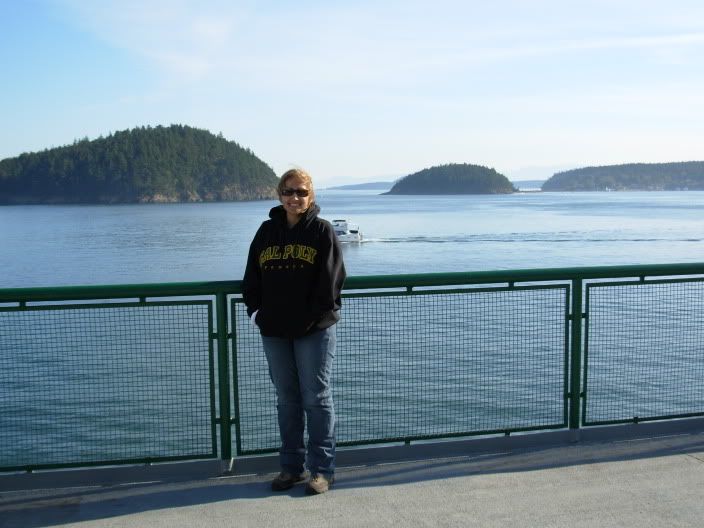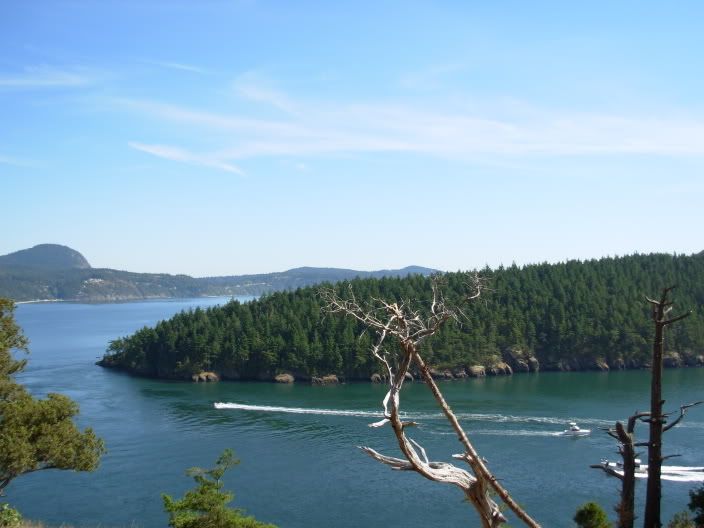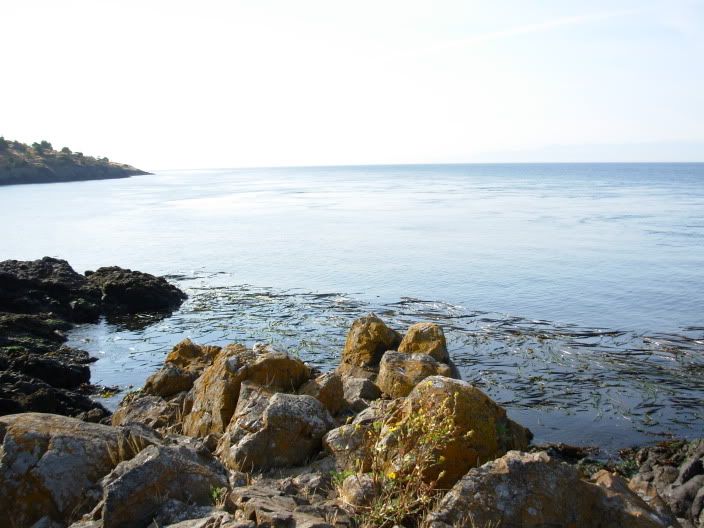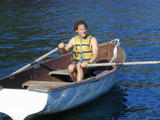 Well today was the day and we all new it was coming: The Swim Test. We first learned how totie some knots, which let me add I am not so good. I got only one of the four or five down pack. Erin is great since she was living on a sail boat for a semester. I think I will stay around her when it’s time to learn again. We then had a little rowing adventure by the dock’s side. Out to a piling and back was the extent of our adventure. Colleen was my partner in the boat and I felt bad for her because I was no good at that either. I didn’t suck, but rather needed a huge improvement. Ok here it comes the swim test. I had first walked out there with my heavy Monterey Bay reversible fleece jacket so I could get nice and hot, then the water would look inviting. Nah! The water still looked cold.
Well today was the day and we all new it was coming: The Swim Test. We first learned how totie some knots, which let me add I am not so good. I got only one of the four or five down pack. Erin is great since she was living on a sail boat for a semester. I think I will stay around her when it’s time to learn again. We then had a little rowing adventure by the dock’s side. Out to a piling and back was the extent of our adventure. Colleen was my partner in the boat and I felt bad for her because I was no good at that either. I didn’t suck, but rather needed a huge improvement. Ok here it comes the swim test. I had first walked out there with my heavy Monterey Bay reversible fleece jacket so I could get nice and hot, then the water would look inviting. Nah! The water still looked cold.
After walking around the dock trying to find a good place to jump off of we found some ladders we could swim to and get out of the freezing cold water. Val and Leslie had joined us and we were very excited to see that Val was going to get in with us. Then I was shocked to see him jump in first. Jason was second to jump in and they were floating around acting like the water was anything but cold (Val was more convincing than Jason). We eventually all went in. Donna and i were the last ones and she suggested we go in at the same time. I had to do it or else I was going to just stand there and stare and the water. Well no one screamed after they jumped in except me. No one heard me since it was underwater and I swallowed a whole chunk of salty sea water and probably some oil from the boats docked there. I raced Donna to the ladder so to get out of the freezing cold waterfirst. Luckily it was a nice 78 degrees and once we climbed the ladder it was warm. Leslie got some pretty get pictures and I can’t wait to see them up on the blogbook.
—–
Read More
here are a quick glimpse into the area I am at, now can you see how beautiful it is. I hope to add great orca pics real soon.




—–
Read More
My first day of school normally starts with 150 nervous 7th graders inquiring what middle school math will look like and what they will be covering this year. I have taken a sabatical this year and I have to say that it has been very weird to not go through the steps of buying new school/teacher clothes, setting up my classroom, and mentally preparing myself for a brand new year. I am actually in the reverse roll, because I’m currently enrolled in Beam Reach: Marine Science and Sustainability School. I’m currently on beautiful San Juan Island and on the waters of the Salish Sea for the next 10 weeks. I’m so looking forward to new experiences and hope to explore the idea of a masters in Marine Biology. We were at Lime Kiln today doing an introductory activity and J,K,and L were just south of us. I will have to admit that I was not a very focused student, because my eyes were more in my binoculars than in my notebook. Smile! Please ask me questions about the classes I am taking and I would love to share in more detail. I’ll give you a quick overview of my schedule so you know when I’m here at the Friday Harbor Marine Labs. Call me or email me, I’m not that far away. So, for the next three weeks we will be here on land; formulating our research question and laying out the proposal for our project. Then we will go to sea for two weeks and try out our methodology, sampling protocols, and get familiar with our sustainable life at sea. We’ll follow this with one week back at the labs, analyzing our preliminary data and verifying that we are on track with our research project. Then we head out for three weeks at sea (eeee…I can’t tell you how excited I am for that). Finally, our last week will be on land. Looking over our data, analyzing it, and writing up our findings. Our presentations will be to a high stakes audience to reveal all that we had studied and learned. Well, I’m off to class for now. Enjoy the sunshine!
—–
Read More

It has been marvellous and frustrating to be administering Beam Reach from Seattle on the first days of the fall 2006 program. I feel a simultaneous urge to rush up and be part of every moment in the syllabus and a great satisfaction that the Beam Reach ship is sailing along without me being involved in adjusting every line.
I hope this first blogbook entry will inspire new students and instructors alike to share their experiences on-line. It really is a rare thing these days to delve deeply into a critical issue and one’s own curiosities. That our research theme centers on orcas, an inherently awe-inspiring and communicative species, just makes the opportunity that much more intriguing.
I’d like to share two journal entries I made almost precisely a year ago, during the first couple days of the first Beam Reach program. They drive home the sense I have again today: that we are just scratching the surface of our human involvement in the decline and unprecedented alteration of the oceans.
Sunday 08/21/2005 05:30
“How much does an ecosystem have to change before we alter our values to restore it? To answer the question, one really has to do two difficult things: understand the ecosystem well enough to determine which human actions are driving the change; and discern what changes in human behavior will benefit the ecosystem at least cost.
Beam Reach is all about addressing this question in the marine environment through sustainability science. This is daunting because it is technologically difficult to analyze how marine ecosystems function and to quantify the costs/benefits of human actions within them. It is also a challenge because scientists are used to understanding a ecosystem problem, but have not traditionally studied how to solve it (through economic, technological, and/or political methods).
In the Pacific Northwest, we have an interesting range of cases in which this broad question has been tackled. Invariably they begin with the decline of a species — whether high-profile or obscure — and evolves to a broad investigation of its ecosystem. At present, we are considering a charismatic megafaunum, the southern resident orcas. We are also currently struggling with another deeply valued animal, the wild salmon. We can report the successful restoration of the iconic American bald eagle. Great sums have been invested recently in assessing the Stellar sea lion, which most people don’t value in particular. And we are still evaluating the status of the northern spotted owl, a species that many people hate as much as orcas used to be reviled.
If it turns out that noise from cargo ships is the main risk to orcas staying in residence, at what point will human individuals and society mitigate the acoustic impact? Will orcas, inherently wonderful and with ecotourism value of about $1M/animal, be compared economically with the goods being transported through the great ports of our region? How much would it cost to make those ships quiet?”
Wednesday 08/24/2005 (2:05am 8/25)
“It is strange to reside in such a beautiful marine setting while reading articles and hearing speakers declare emphatically that marine ecosystems are in collapse. With a nostalgia as invigorating as the fresh evening air, I stepped out onto the Fernald Lab deck to gaze at the half-full, waning moon. Friday Harbor rippled in the dark waters and the wet beach glistened beneath me. After strolling back to the duplex, I found emailed news about marine extinctions and prepared to introduce 2 speakers who document the decline of pelagic fish and orcas in our oceans.
Bleary eyed, I ease into bed wondering where the southern residents are tonight. Are we really helping the whales, as I tell my son Liam when he asks what I do with Beam Reach?”
Just as I came across unnerving news regarding the marine plight last year, today I came across an L.A. Times series called “Altered Oceans.” Reading through the part on ocean acidification while my newborn daughter snored beside me, I was felt downright worried about the anthropogenic perturbations of the globe we are set to experience in the 21st century. Nevertheless, I am optimistic that Beam Reach is a small step in the right direction and I’m very excited to continue contemplating how to forge a sustainable relationship between humanity and the seas.
—–
Read More
I just got here to Friday Harbor and it is beautiful. I hope all would be able to have the experience I am about to embark but realize they cannot, so I am to describe what I learn and feel and hope I do it justice. This has been my first access to the internet so I will keep it short. I saw my first wild orca today through binoculars. They were so far away and I can’t wait to get a safe closer look.
I would like to quote our presidente Scott Viers who wrote in his blog:
“How much does an ecosystem have to change before we alter our values to restore it? To answer the question, one really has to do two difficult things: understand the ecosystem well enough to determine which human actions are driving the change; and discern what changes in human behavior will benefit the ecosystem at least cost”
I hope to get more than just the tip of the iceberg to those two difficult things and even more to do it in ten weeks.
—–
Read More
I think a tradition was born last Friday, July 28. Sailing, learning, and fun were had by all at our “open boat†event. Captain Todd Shuster gave tours and sails on his recently re-powered catamaran. Now the west coast’s only biodiesel-electric charter sailing vessel. We listened to an underwater hydrophone (wow, it can be loud under water!), watched video footage from the Beam Reach program last fall, heard recorded killer whale sounds, and we all met interesting people. Here are some photos from the event.
Everyone marveled at the near silence of the Gato Verde’s electric motors. In fact, the only real reason you knew the motors were on was because we were moving, but the sails were down. There was wind so we were also treated to sailing under wind power alone.
Beam Reach alums Celia Barrosso and Laura Christoferson were on hand to tell people what it was like for them to study killer whales for ten weeks — five of which were at sea aboard the Gato Verde. For both it remains a highlight of their lives and continues to provide inspiration and guidance to their careers.
We’d love to hear your thoughts on the day. Post a comment to this article so everyone can learn from you and hopefully be inspired to attend next year’s event.
Read More
I think a tradition was born last Friday, July 28. Sailing, learning, and fun were had by all at our “open boat†event. Captain Todd Shuster gave tours and sails on his recently re-powered catamaran. Now the west coast’s only biodiesel-electric charter sailing vessel. We listened to an underwater hydrophone (wow, it can be loud under water!), watched video footage from the Beam Reach program last fall, heard recorded killer whale sounds, and we all met interesting people. Here are
some photos from the event.Everyone marveled at the near silence of the Gato Verde’s electric motors. In fact, the only real reason you knew the motors were on was because we were moving, but the sails were down. There was wind so we were also treated to sailing under wind power alone.
Beam Reach alums Celia Barrosso and Laura Christoferson were on hand to tell people what it was like for them to study killer whales for ten weeks — five of which were at sea aboard the Gato Verde. For both it remains a highlight of their lives and continues to provide inspiration and guidance to their careers.
We’d love to hear your thoughts on the day. Post a comment to this article so everyone can learn from you and hopefully be inspired to attend next year’s event.
 Well today was the day and we all new it was coming: The Swim Test. We first learned how totie some knots, which let me add I am not so good. I got only one of the four or five down pack. Erin is great since she was living on a sail boat for a semester. I think I will stay around her when it’s time to learn again. We then had a little rowing adventure by the dock’s side. Out to a piling and back was the extent of our adventure. Colleen was my partner in the boat and I felt bad for her because I was no good at that either. I didn’t suck, but rather needed a huge improvement. Ok here it comes the swim test. I had first walked out there with my heavy Monterey Bay reversible fleece jacket so I could get nice and hot, then the water would look inviting. Nah! The water still looked cold.
Well today was the day and we all new it was coming: The Swim Test. We first learned how totie some knots, which let me add I am not so good. I got only one of the four or five down pack. Erin is great since she was living on a sail boat for a semester. I think I will stay around her when it’s time to learn again. We then had a little rowing adventure by the dock’s side. Out to a piling and back was the extent of our adventure. Colleen was my partner in the boat and I felt bad for her because I was no good at that either. I didn’t suck, but rather needed a huge improvement. Ok here it comes the swim test. I had first walked out there with my heavy Monterey Bay reversible fleece jacket so I could get nice and hot, then the water would look inviting. Nah! The water still looked cold.







 Twitter
Twitter LinkedIn
LinkedIn Facebook
Facebook